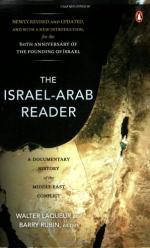
|
| Name: _________________________ | Period: ___________________ |
This test consists of 15 multiple choice questions and 5 short answer questions.
Multiple Choice Questions
1. How many Jews were allowed to get into Palestine by the White Paper of 1939?
(a) 75000.
(b) 150000.
(c) 15000.
(d) 20000.
2. What would the cease fire line of 1967 be a source of according to Hassanain Haykal?
(a) A new country.
(b) Conflict.
(c) Hope.
(d) Peace.
3. Who was Egypt president in 1973?
(a) Moubarak.
(b) El-Sada
(c) Anwar Sadat.
(d) Nasser.
4. To whom did Vladimir Zo'ev Jabotinsky writes?
(a) The Jewish Concil.
(b) The New York Post.
(c) The Palestine Royal Commission.
(d) The League of Nation.
5. Where were the British suppose to leave Palestine?
(a) August 1, 1950.
(b) August 1, 1948.
(c) August 1, 1949.
(d) August 1, 1951.
6. What did the Anglo-American Committee hope would curb hostility between Jews and Arabs in Palestine?
(a) Gated communities.
(b) Two countries.
(c) Equalizing the disparity in standards of living.
(d) Equal access to American subsidies.
7. What did Hassanain Haykal reveal in the high level Arab leaders?
(a) Strength.
(b) Sense of history.
(c) Shortcoming.
(d) Hope.
8. What did Hassanain Haykal view the conflict for Palestine as a way to do according to Part IV pp. 258-303?
(a) A way to keep Arabs absent from the international scene.
(b) A way to give the Jews compensation for the Holocaust.
(c) A way to punish the Arabs for the religion.
(d) A way of forcing the Arabs to submit to the West.
9. When was the Anglo-American Committee of Inquiry formed according o Part II pp. 72-103?
(a) 1947.
(b) 1948.
(c) 1946.
(d) 1945.
10. When was the Manifesto of the United Arab Republic published?
(a) April, 1963.
(b) April, 1965.
(c) April, 1964
(d) April, 1966.
11. What territories did Israel agree to withdrawn from in U.N. Resolution 242?
(a) Egyptian ones.
(b) Jordanian ones.
(c) Negotiated ones.
(d) Those following the Six Day War.
12. Who was the British Prime minister in 1931?
(a) MacDonald.
(b) Montbaten.
(c) Wilson.
(d) Churchil.
13. Who supported the idea of a Jewish state in Palestine?
(a) Germany.
(b) England.
(c) France
(d) Canada.
14. What was the only course of action for the entire region?
(a) United States intervention.
(b) Negotiation.
(c) United Nation intervention.
(d) Total war.
15. What does a British policy commission recommends against in 1938?
(a) Palestine as one state.
(b) Immigration of Jews.
(c) Support to Arab independence.
(d) Partition of Palestine.
Short Answer Questions
1. What was Jerusalem made by the U.N.?
2. How long of a transitional period did the U.N. set to create provisional governments?
3. What did the most of the educated and most competent Palestinians do, according to Ahmed Baha Ed-Dine?
4. Who called for the total withdrawal of Israel from the territories occupied during the war in response of U.N. Resolution 242?
5. When did the Arabs begin discussion of secession from the Ottoman Empire?
|
This section contains 416 words (approx. 2 pages at 300 words per page) |

|




